Second Lieutenant John Hanley and his team surveyed the grounds of the Dy Pac Lumberyard late on the morning of February 7, 1945. Over the course of the war, the seasoned U.S. 37th Infantry Division soldiers had grown accustomed to witnessing battlefield violence. But there amid the towering weeds in a northern Manila field, the troops found that the dead did not wear helmets and camouflage fatigues but rather flower-print dresses, nightgowns, and even infant sleep suits.
Four days earlier—just hours after American forces had rolled into the Philippine capital—Japanese troops had rounded up more than 100 suspected guerrillas and their families and herded them into this field less than three miles from the presidential palace. The troops then proceeded to behead the men one after the other in an assembly line of horror. Women and children, including infants, were bayoneted. Hanley and his men, who counted 115 dead—some of whom were stacked in piles—observed that the blood was so copious, it had created streams in the dirt.
“On the adult bodies,” Hanley reported, “the hands were tied.”
“It appeared whole families had been killed,” Private First Class Claude Higdon Jr. added in an affidavit.
The massacre in the Dy Pac Lumberyard was not an anomaly. American soldiers would soon discover that this was only the first of dozens of atrocities committed during the Battle of Manila. For 29 days, as American troops battled through the Philippine capital, Japanese soldiers and marines systematically slaughtered tens of thousands of civilians in what investigators later described as an “orgy of mass murder.”
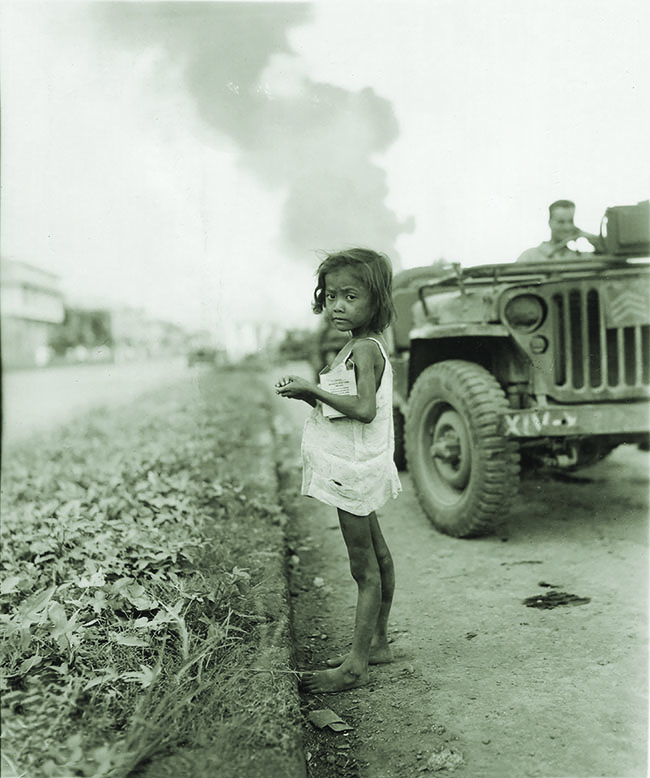
Captured battlefield records reveal that the violence was not haphazard but planned and organized. “When Filipinos are to be killed, they must be gathered into one place and disposed of with the consideration that ammunition and manpower must not be used to excess,” one order stated. “Because the disposal of dead bodies is a troublesome task, they should be gathered into houses which are scheduled to be burned or demolished. They should also be thrown into the river.”
General of the Army Douglas MacArthur, who had lived in Manila before the war and had hoped to spare the city, was outraged. Even before the battle was over, he ordered his forces to investigate all reported atrocities. The thousands of pages of affidavits, reports, and photographs formed the basis for the first war crimes trial in Asia. Summarizing what happened in Manila, London Daily Express reporter Henry Keyes wrote, “At last the Japanese have matched the [1937-38] Rape of Nanking.”
MACARTHUR, DRIVEN FROM the Philippines at the start of the war, had famously vowed to return. For the general, it was personal. During the Spanish-American War, his father, Brigadier General Arthur MacArthur, had helped capture Manila and served as the Philippines’ military governor when it became a new American colony. During the four decades of U.S. administration, Manila had blossomed into a small slice of America in Asia, home not only to thousands of U.S. service members, but to employees of companies like General Electric, Del Monte, and B. F. Goodrich.
Douglas MacArthur’s life, like that of his father, was intertwined with the Philippines, where he was first posted after graduating West Point in 1903. He returned to the islands repeatedly throughout his career, developing close personal relationships with political leaders. “In this city,” he once wrote, “my mother had died, my wife had been courted, my son had been born.” For MacArthur, who had spent his life pinballing around the world as the son of a career military officer, Manila was the closest thing he had to a hometown.
Many others loved the beautiful city as well. “To live in Manila in 1941,” remembered CBS news correspondent Bill Dunn, “was to experience the good life.”
But the good life ended on December 7, 1941, when the Japanese attacked Pearl Harbor and, a few hours later, bombed the Philippines. Hoping to spare Manila, MacArthur declared it an open city—meaning the United States had no intention of defending it—and evacuated his forces to the Bataan Peninsula and the fortified island of Corregidor. This was far more than a strategic retreat to MacArthur. He was abandoning his home, forced to flee so fast that the family did not have time to take down the Christmas tree.
The Japanese occupied Manila on January 2, 1942, rounding up thousands of American civilians and interning them at the University of Santo Tomas, in the city’s north. MacArthur endured 77 days in the tunnels of Corregidor before escaping, upon President Franklin D. Roosevelt’s order, on March 11, 1942, in a PT boat under the cover of darkness. For MacArthur, it was agonizing, being forced to leave behind thousands of American soldiers who had trusted him—troops who would soon face the Death March followed by years in Japan’s notorious prisoner-of-war camps.
Manila suffered greatly during the three-plus years of the enemy’s occupation. Japanese forces looted food supplies, medicines, and department stores, stole farm equipment, and left fields to rot. The city’s economy collapsed and its social fabric began to unravel. “It is cheaper to buy a child than a hog in the City of Manila today,” one American intelligence report noted in 1944. Starvation claimed as many as 500 souls a day. American families, locked up behind the gates of Santo Tomas, suffered equally, forced to eat dogs, cats, and even rats to survive. “I was worried about a lump in my stomach,” internee Louise Goldthorpe wrote in her diary. “Then I found it was my backbone.”
MACARTHUR DELIVERED ON his promise to return to Luzon on January 9, 1945, when American soldiers sloshed ashore at Lingayen Gulf and began the 110-mile drive south to Manila. Standing in MacArthur’s way was Japanese general Tomoyuki Yamashita, the senior military commander in the Philippines and legendary “Tiger of Malaya.” Yamashita’s job was to turn the Philippines into a tar pit and bog down American forces.
Built like a bear, the 59-year-old Yamashita was famously unattractive, with a bald, egg-shaped head that earned him the nickname among Filipinos of “Old Potato Face.” The Fourteenth Army commander, however, had proven himself early in the war, seizing Singapore and Malaya in a lightning-fast campaign against British defenders who outnumbered his troops three-to-one. A rivalry with War Minister Hideki Tojo had moved the latter to stick Yamashita in Manchuria for much of the war. Tojo’s ouster following the fall of the Marianas in mid-1944 paved the way for Yamashita’s resurrection.
The portly general did not plan to fight for Manila, however; he believed the city, crowded with hostile civilians, would be too difficult to defend. Instead he divided his army into different geographic areas and prepared to fight a protracted battle in the mountains and jungles of Luzon.
Rear Admiral Sanji Iwabuchi had other ideas. The commander of the Manila Naval Defense Force, Iwabuchi, 49, had been assigned the job of staying behind to wreck the city’s port and waterfront so as to rob American forces of strategic assets. His orders mandated that he withdraw afterward. Iwabuchi, though, had no intention of abandoning the capital.
Early in the war, American forces had destroyed Iwabuchi’s battleship, Kirishima, off Guadalcanal. Iwabuchi had spent much of the rest of the war parked behind a desk, an insult to any seafaring officer during wartime. Only through Japan’s worsening fortunes—and the death of so many more capable officers—had he been given a second chance. Iwabuchi saw in Manila a chance to redeem himself by creating an urban bloodletting similar to that at Stalingrad.
To do this, Iwabuchi divided his 17,000 men into several geographic commands that covered northern, central, and southern Manila. Iwabuchi’s ultimate plan called for a defense centered on Intramuros, Manila’s ancient citadel guarded by towering walls.
Around Intramuros, which translates roughly from Spanish as “Walled City,” Iwabuchi prepared a perimeter of large concrete buildings that resembled small fortresses, each designed to withstand typhoons and earthquakes. Throughout January—and prior to the arrival of MacArthur’s forces in the city—Japanese troops barricaded rooms with desks, chairs, and bookcases. In the corridors, they built staggered, dirt-filled walls four feet thick and seven high, with just enough clearance over which to toss hand grenades. Iwabuchi’s forces likewise booby-trapped dozens of intersections, sinking railroad ties into the pavement to act as roadblocks and tank traps, and converting depth charges into land mines.
To retake Manila, American forces carved up the city. The 37th Infantry and 1st Cavalry divisions would approach Manila from the north. The 37th Infantry would cross the Pasig River near Malacañang Palace, turn west, and drive toward Intramuros and the waterfront. The 1st Cavalry would envelop the capital from the east, crossing the river farther south before turning toward the bay, a thrust that would parallel the infantry. The 11th Airborne Division would come up from the south and close the city’s back door.

With these preparations in place, MacArthur was convinced the Japanese would evacuate the city, just as he had done at the start of the war. The general was so confident of this that he ordered his staff to plan a liberation parade.
Complicating the challenge for American war planners was the mix of intelligence they were receiving. Guerrilla messages from early December 1944 reflected Yamashita’s intention to abandon the city. By January, the messages changed, pointing to Manila’s fortification.
“Japs erect pillboxes, trenches and roadblock on main streets,” one message stated.
“Defensive preparation of civilian homes,” read another.
Residents who for years had anxiously awaited the return of MacArthur now worried over the hell liberation might bring—a sentiment journalist Pacita Pestaño-Jacinto captured in her diary. “Defeat is a bitter pill that the Japanese will not swallow,” she wrote. “Defeat is the one thing that can make them turn into beasts.”
AMERICAN FORCES ROLLED into Manila at 6:35 p.m. on February 3, 1945, freeing the nearly 3,700 internees at the University of Santo Tomas that night, many of whom were on the verge of starvation. Internee Tressa Roka captured the euphoria in her diary. “Before the men in the tanks knew what was going on, they were pulled out of them and lifted on the shoulders of our scrawny fellow internees,” she wrote. “It was impossible to hold back the worshipping and joyous internees.”
But the excitement over the Americans’ arrival would prove short-lived.
That same day, Iwabuchi gave the order to begin the destruction of Manila. Incendiary squads swept through the districts north of the Pasig River, setting fires and dynamiting buildings. “The spectacle was an appalling sight. The entire downtown section of the city was a mass of flames,” MacArthur’s pilot, Weldon E. “Dusty” Rhoades, wrote in his diary. “Flames were rising 200 feet in the air from the center of the city.”
The destruction infuriated Major General Robert S. Beightler, commander of the 37th Infantry Division. “We were powerless to stop it—we had no way of knowing in which of the thousands of places the demolitions were being controlled,” the general wrote in a report. “Big, modern, reinforced concrete and steel office buildings were literally blown from their foundations to settle crazily in twisted heaps.”
At the same time, Japanese forces started killing suspected guerrillas—beginning with the murder of the 115 men, women, and children at Dy Pac Lumberyard. Over the next few days, enemy troops killed former constables, police officers, and even several priests suspected of being loyal to the United States.
American soldiers crossed the Pasig River on February 7 and began what would turn out to be an incredibly bloody urban fight to retake southern Manila. Block by block, they battled deeper into the capital city, frequently slowed by the enemy’s fortifications at intersections, which required troops to blast their way through adjacent buildings in order to attack the rear of a Japanese pillbox. “Gains were measured more by street intersections cleared rather than city blocks secured,” one infantryman recalled. Just as perilous were the fortified buildings, where Japanese marines used the higher floors to target the advancing American forces.
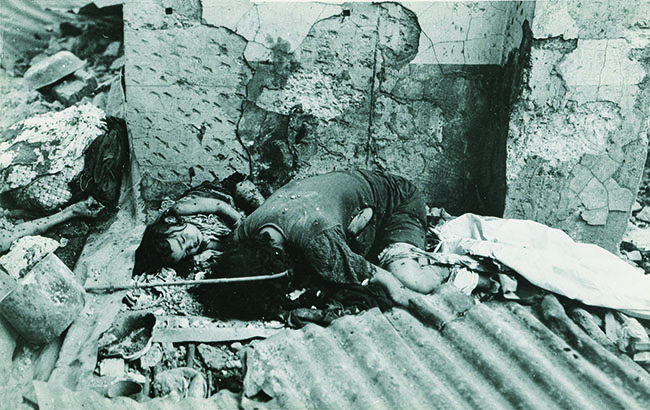
MacArthur initially refused to allow planes to bomb the city for fear of killing civilians, but he relented and permitted artillery after troops suffered heavy losses crossing the river. “From then on,” General Beightler said, “we really went to town.”
BY FEBRUARY 9, just six days after American troops entered the city, Iwabuchi realized the battle was lost. MacArthur’s forces were across the river and pressing deep into Manila while the Japanese admiral’s fortifications along the city’s southern border threatened to collapse. The Americans had more firepower and far more troops. What had started as a fight between two armies over one of Asia’s great cities devolved into one of the worst human catastrophes of World War II. An examination of the timeline of the dozens of atrocities that occurred in Manila points to February 9 as the fulcrum on which the violence shifted from individual attacks against suspected guerrillas to organized mass extermination.
Captured Japanese orders found on the smoldering battlefield—some mere fragments, others signed and dated—would later reveal that the atrocities were part of a systematic plan to destroy the city and annihilate its inhabitants. “The Americans who have penetrated into Manila have about 1000 artillery troops, and there are several thousand Filipino guerrillas. Even women and children have become guerrillas,” one such order stated. “All people on the battlefield with the exception of Japanese military personnel, Japanese civilians, and special construction units will be put to death.”
That battlefield, of course, was the city.
Japanese marines fanned out that day through the district of Malate, rounding up hundreds of civilians and herding them into the cavernous dining hall at Saint Paul’s College, promising them safety from the battle. The chandeliers, rigged with explosives, suddenly dropped to the floor and detonated. The explosion was so powerful it blew the roof off the building and a hole in the western wall large enough for a truck to drive through it. Those who could stumbled out through the collapsed wall, pursued by the Japanese who shot and bayoneted survivors, ultimately killing 360 people. “We walked over dead children and mothers with children,” one of the few survivors recalled.
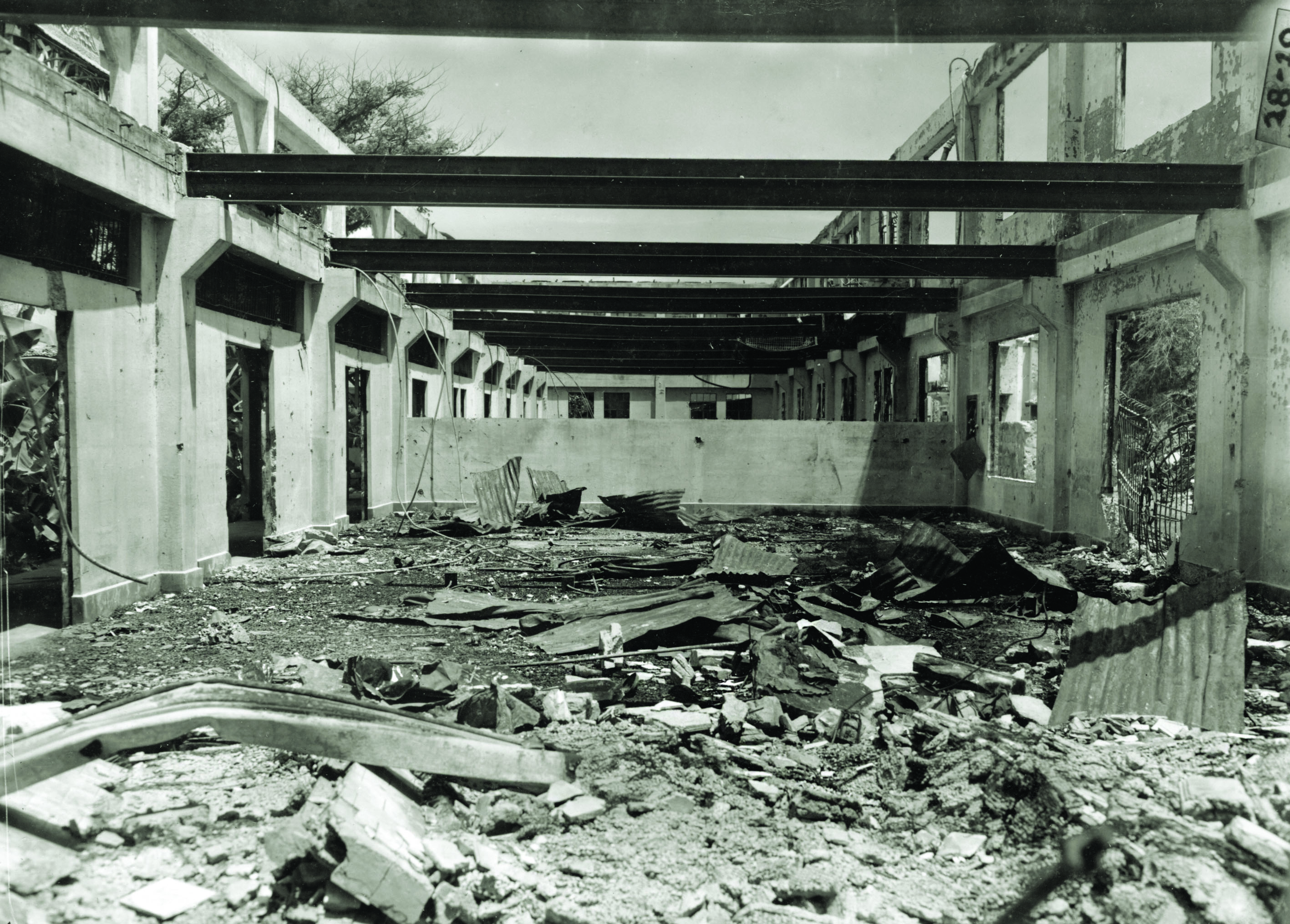
But the horror had only begun.
The following afternoon, Japanese marines stormed the Red Cross headquarters, going room by room shooting and bayoneting more than 50 civilians, including two infants—one just 10 days old. John Lewy, a Jew who had fled Germany, survived by pretending to be dead. The Japanese, however, murdered his fiancée. “When I came to my senses, I thought it was a dream,” he later told war crimes investigators, “but everybody was dead.”
Corazon Noble, who before the war was a Filipina film star, was shot in the right elbow and then bayoneted nine times while she tried to cover her 10-month-old daughter. Despite Noble’s efforts, the bayonet sliced completely through the baby three times. “After they left, I tried to put her intestines back in her stomach,” said Noble, whose daughter died that afternoon. “I did not know what to do.”
That same day, Japanese forces surrounded the German Club, a large social hall where more than 500 civilians had gathered in the crawlspace for protection against the shellfire. The Japanese doused the club’s furniture with gasoline and set it on fire. Others then blocked the crawlspace openings with suitcases residents had brought and burned them, too. The men who wriggled out to escape were gunned down. The females who fled faced a far worse fate. Recalled survivor Esperanza Esteban: “The Japanese caught some of the women, poured gasoline on their heads and set their hair on fire.”
In one of the more gruesome crimes, the Japanese converted a home at 1195 Singalong Street into a house of horrors. Troops cut a hole in an upstairs floor and then marched everyone from blindfolded teenagers to grandfathers inside and forced them to kneel. A Japanese marine then slashed each man’s neck with a sword before kicking the body into the hole. Two hundred men died this way, though nine ultimately survived, watching as body after body tumbled down the hole, forming a pyramid of tangled arms, heads, legs, and torsos. “I placed my hand and arm on the floor,” recalled survivor Virginio Suarez. “I could feel several inches of blood.”
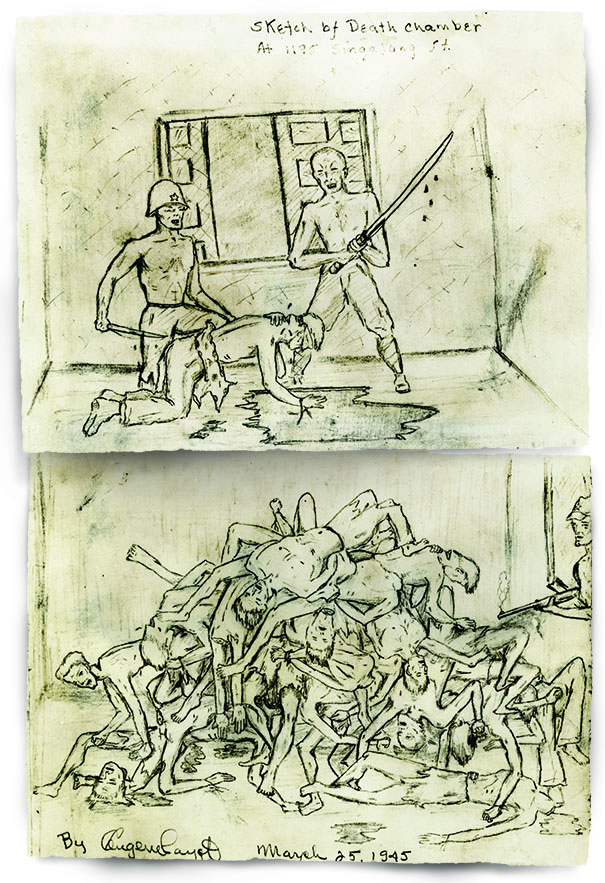
Large massacres, like those at Saint Paul’s, the German Club, and the Red Cross, went hand in hand with scores of small-scale and often undocumented atrocities as marauding troops attacked families in homes and pulled others out of bomb shelters, butchering them in the streets. The Japanese went so far as to lure victims into an open lot on Kansas Street by planting a Red Cross flag.
To escape the flames and artillery, refugees often congregated in the large compounds of some of the city’s wealthiest citizens, whose elegant concrete homes offered protection from flying shrapnel and whose gardens served as firebreaks. However, these proved easy targets for the enemy, who encircled the homes, set fire to them, and shot any escapees. “The Japanese wanted to be sure that everybody was dead,” testified one survivor.
The atrocities went beyond murder. The Japanese rounded up hundreds of women, locking many of them inside the luxurious Bayview Hotel, where Jean MacArthur lived before she married the general. For days, in the rooms where tourists had once enjoyed Manila’s legendary sunsets, Japanese troops assaulted scores of women. “I was raped between 12 and 15 times during that night. I cannot remember exactly how many times,” Esther Garcia Moras later testified. “I was so tired and horror stricken that it became a living nightmare.”
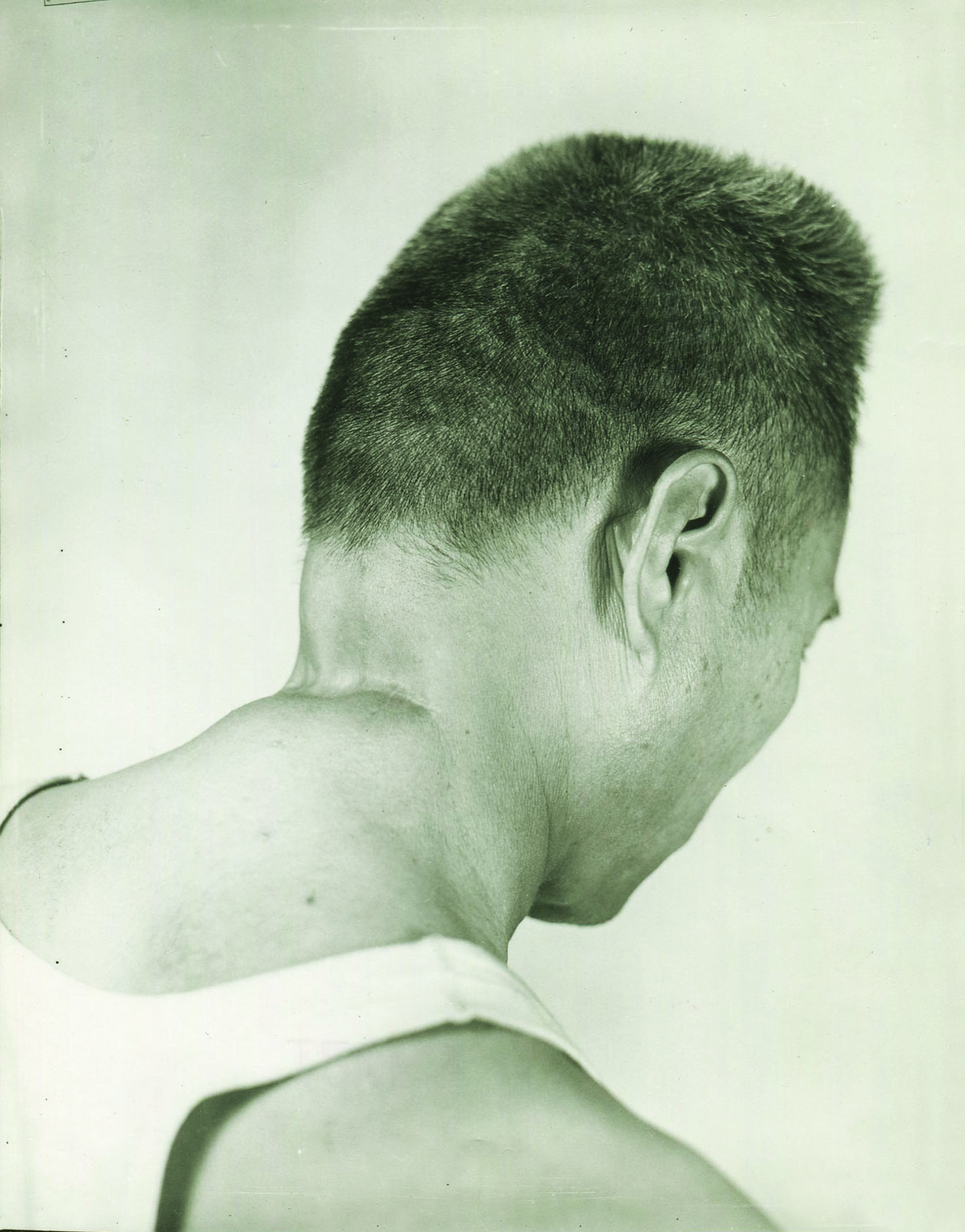
The Japanese did not discriminate: they slaughtered Russians, Spaniards, Germans, and Indians. Troops killed men and women, the old and the young, the strong and the infirm. The butchered victims included two Philippine Supreme Court justices, the family of a Philippine senator, and scores of priests. “The list of known dead that has come to my attention sounds like a Who’s Who of the Philippines,” Manila attorney Marcial Lichauco wrote in his diary on February 19. “Judges, lawyers, bank directors, doctors, engineers and many other well-known figures in public life now lie rotting in the ruins and ashes of what was once the exclusive residential districts of Malate and Ermita.”
Those residents who were able fled—a perilous journey through an apocalyptic wasteland, one best described by Life magazine photographer Carl Mydans. “All morning we had seen the long files of people walking mutely rearward past advancing infantry,” he wrote. “Some of them limped with improvised wound dressings. Many of them walked, heaven knows how, with open wounds.” Internee Robert Wygle described the parade of wounded who came to Santo Tomas in search of help. “They are so far beyond recognition,” he wrote, “that, in many cases, one can’t tell whether they are men or women, boys or girls, dead or alive.”
THE STORIES TOLD BY the survivors outraged American commanders, MacArthur in particular. “Desire full details of all authenticated cases of atrocities committed by the enemy in the Manila area as soon as possible,” the general ordered on February 17.
That effort began in earnest after American forces secured the city on March 3, just 29 days after troops first rolled into Manila and liberated Santo Tomas. Victory had proven costly—613 city blocks flattened, an estimated 100,000 civilians dead, and another 200,000 homeless. Iwabuchi, the architect of the horror, had committed suicide in the waning days of the battle.
Army investigators fanned out through the ruins, interviewing victims—including many still confined to hospital beds—and ultimately producing thousands of pages of sworn testimony. Others photographed wounds and walked through massacre sites alongside survivors, sketching diagrams and taking photos. The exhaustive work identified 27 major atrocities in Manila. The list, of course, was by no means complete, despite the diligence of investigators. In some cases, entire families had been slain, leaving no one to report the massacre. Other times survivors, whose homes were burned and families killed, chose to abandon the city.
The victims had come from various socioeconomic backgrounds. Some spoke fluent English, while Spanish, Chinese, and Tagalog translators had to be enlisted to interview others. More than a few were illiterate, signing their sworn statements with the letter “X.” At times, victims broke down, which was dutifully noted in each statement. “The witness appeared too grief-stricken to testify at more length,” one investigator observed.
Interviews with sexual assault survivors proved some of the hardest. Investigators in the Bayview case noticed the “extreme reticence” of many victims to describe what had happened to them. Investigators likewise interviewed children—at times among the few survivors of a particular massacre.
Page after page of testimony revealed the struggle victims had in comprehending why the Japanese had perpetrated such cruelty against them. Many who had lost loved ones were understandably bitter and hostile.
“My future life is only for vengeance,” declared Dr. Walter Frankel, a Jewish refugee from Germany who watched the Japanese fatally shoot his wife in the neck.
Even American investigators were at a loss to fathom the widespread butchery, exhausting the thesaurus for adjectives like “diabolical,” “inhuman,” and “savage.” The numerous atrocity reports often included commentary by investigators about how humans could commit such barbarities.
“This orgy of looting, raping, and murder defy credence, were it not for the mass of indisputable evidence establishing its commission,” one report read.
Stated another: “Cannibals in the lowest strata of life could have pursued no crueler methods.”
THE INVESTIGATORS’ TENACIOUS WORK formed the basis of the prosecution’s case in fall 1945 against General Tomoyuki Yamashita, who had walked out of the mountains of northern Luzon and surrendered on September 2, 1945. In a battle-scarred courtroom in downtown Manila, Yamashita was put on trial, accused of failing to control his troops, including those under the direct command of Admiral Iwabuchi. The 123 charges against him accounted for 62,278 tortured and murdered civilians, 144 slain American officers and enlisted men, and 488 raped women.
Over the course of 32 days, the Battle of Manila was replayed before a panel of five judges and a total of 16,000 spectators, who jammed into the courtroom, sitting shoulder to shoulder each day to watch the war crimes trial. A parade of 286 witnesses—doctors, lawyers, teachers, and nurses—testified about what had happened to them or their loved ones. Many displayed graphic scars from the battle, including Rosalinda Andoy, 11, who lifted her faded pink dress to reveal the 38 bayonet wounds she suffered on her chest and stomach.
Yamashita, who was in the mountains of northern Luzon during the battle, denied any knowledge of the massacres, blaming the carnage on the deceased Iwabuchi. Prosecutors could produce no document directly tying Yamashita to the massacres, but built a circumstantial case that the atrocities were too widespread and organized for him not to have known. Furthermore, as other Japanese military leaders testified, Yamashita was in radio contact with Manila throughout much of the battle. At a minimum, prosecutors argued, he should have been aware. “It was his duty to know what was being done by his troops, under his orders, under his commands,” chief prosecutor Major Robert M. Kerr stated in closing.
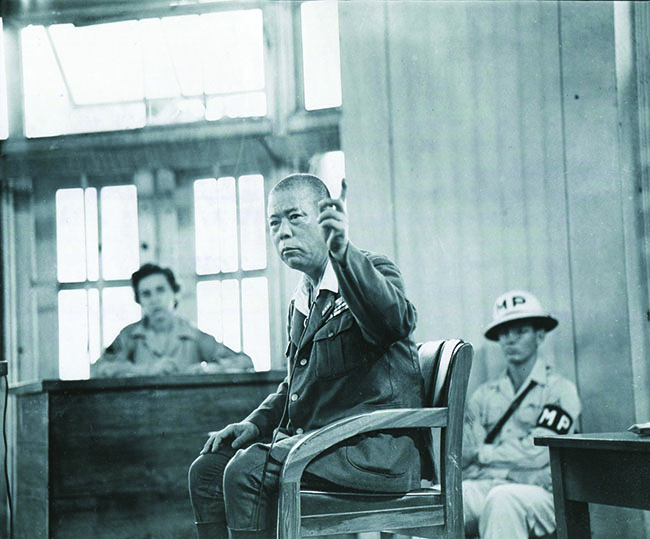
Yamashita was convicted on December 7, 1945. His dogged defense lawyers appealed his case to the Supreme Court of the Philippines and the U.S. Supreme Court, but ultimately lost. On February 23, 1946, in a sugarcane field near Los Baños, some 40 miles south of Manila, Yamashita was hanged—having been stripped of all decorations and even his officer’s uniform, as MacArthur had ordered.
Yamashita’s execution did little to provide solace for the victims. Many would battle years of physical torment, including Cayetano Lagdameo, who at 19 survived Japanese efforts to decapitate him with a sword in the Singalong death house, forever tattooing his neck with a 10-inch scar. “During cold days,” Lagdameo said years later, “the scar still aches.”
Other victims wrestled with emotional wounds. Five-year-old Fernando Vasquez-Prada, who watched Japanese marines butcher his mother, father, and three brothers, refused to speak for two years. “I could not talk,” he later said, “could not say a word.” Scores more struggled to understand the level of barbarity inflicted upon them. “It was just total hatred and savagery,” explained Juan Jose P. Rocha, whose mother was killed by shrapnel. “You cannot explain it.”
Nearly a half century after the battle, survivors formed an organization—the Memorare–Manila 1945 Foundation—dedicated to preserving the story of the civilian sacrifices to the city’s liberation. To memorialize those killed, the organization erected a statue in Intramuros of a weeping mother cradling a dead infant, surrounded by other dead or dying figures. The inscription at the base of the statue provides a powerful epitaph for the tens of thousands of men, women, and children who died during those terrible weeks in February 1945. “This memorial is dedicated to all those innocent victims of war, many of whom went nameless and unknown to a common grave, or never even knew a grave at all, their bodies having been consumed by fire or crushed to dust beneath the rubble of ruins,” the inscription reads. “Let this monument be the gravestone for each and every one.”
This article originally appeared in the December 2018 issue of World War II magazine.





